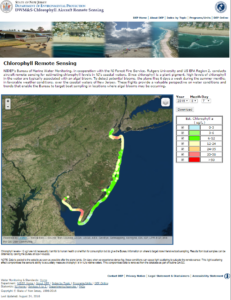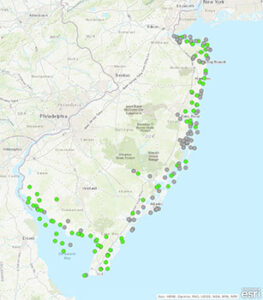Algal Bloom Monitoring
The purpose of NJDEP’s Bureau of Marine Water Monitoring’s (BMWM) Algal Bloom Monitoring Program is to ensure safe shellfish harvest by avoiding contaminated Harmful Algal Bloom producing bio toxins. HAB’s represent a small subset of phytoplankton species that negatively affect human, animal, and ecosystem health. As part of the State’s compliance with the National Shellfish Sanitation Program (NSSP), NJ is required to develop a BioToxin Contingency Plan that includes control measures for marine biotoxins. For more details on HABs, see our Marine Harmful Algal Bloom fact sheet .
To protect against HABs and to comply with the NSSP, BMWM manages the two programs below.
Air Craft Remote Sensing Program
Extensive Spatial Coverage
Through air craft remote sensing, BMWM is able to monitor an expansive area of NJ’s coastline for potential algal blooms. Since monitoring is performed from the air, access to waters along the coast are never an issue.
Evaluate Daily Changes
Management can monitor the day to day sensor results to determine if a potential algal bloom is beginning to develop and in which part of the state.
Cost Effective
The acquisition of this data is done primarily through integration of a remote sensor, laptop, and GPS. All parts are programmatically synced up to measure chlorophyll ‘a’ concentrations. Once setup is complete, minimal costs are required to operate and maintain the system throughout the year.
Strategic Deployment of Staff
High Chlorophyll ‘a’ values can potentially indicate the presence of a Harmful Algal Bloom (HAB). If the remote sensor indicates elevated Chlorophyll ‘a’ levels, NJDEP will strategically deploy staff to the observed areas of high concentration to collect samples. The samples are analyzed at the Leeds Point laboratory to determine if a HAB species is occurring.
Multiple Partner Cooperation
Our Remote Sensing Program could not be done without the cooperation of the NJ Forest Fire Service, Rutgers University, and USEPA Region 2.
Phytoplankton Monitoring Program
Over 45 Monitored Stations
Over 45 fixed stations are visited multiple times during the year. Samples are collected and brought back to the Leeds Point laboratory facility to determine if any Harmful Algal Bloom (HAB) species are present.
Collected Year Round
To help with identification of Harmful Algal Blooms (HAB), the bureau collects water samples year round throughout the coastal waters of NJ.
Integrated into National Shellfish Sanitation Program
BMWM has integrated the monitoring of Harmful Algal Blooms (HAB) into its routine National Shellfish Sanitation Program (NSSP) network. This optimizes both the temporal and spatial frequency when monitoring for potential HAB development.
You can help…
Besides being potentially toxic to humans through shellfish consumption, algal blooms may have other harmful effects including marine fauna kills, mild toxicity to bathers and reduced aesthetic quality.
If you have observed discolored coastal water within the past week, note the location (longitude & latitude if possible), date and time that you made the observation, and general description of the location. You can then contact the NJDEP Hotline at 1-877-WARN-DEP. In addition, you may also contact us with concerns and additional information.
For more information related to HABs, you can visit the Division of Water Monitoring, Standards & Pesticide Control(DWMS&PC) and Bureau of Freshwater & Biological Monitoring HAB pages.

